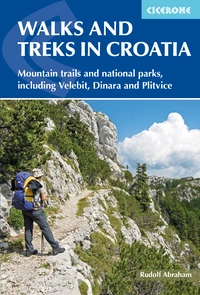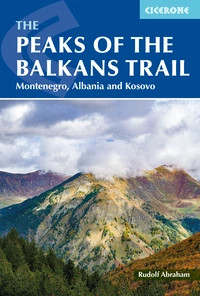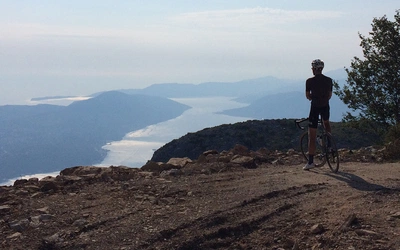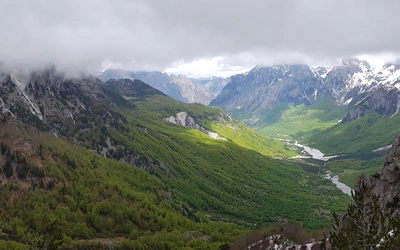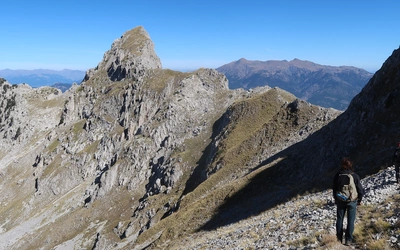Hiking along the island trails of Croatia
Croatia’s beautiful islands might not be particularly high but they are wonderful places to hike, says Rudolf Abraham
The trail along the eastern coast of Rab runs above steep, rocky slopes that plunge down into the clear blue waters of the Adriatic, bare except for the occasional stunted tree bent double by the infamous northeast wind, the bura. To the east and northeast, the view stretches to the mountains of Velebit and Gorski kotar on the mainland, across low islands that rise out of the sea like grey-bronze whalebacks. It’s a starkly beautiful scene, across which the narrow path leads me alongside dry stone walls, where lizards dart across the rocks under a bright mid-summer sun.

Croatia is blessed with one of the most beautiful stretches of coastline anywhere on the Mediterranean – wildly indented, phenomenally rocky and washed by the intense blue-green waters of the Adriatic, its surface at times so smooth and still it looks as though it’s made of glass, at others whipped into hordes of white horses by the bura.
Rab is just one of the many islands scattered off the Croatian coast – there are well over 1100 of them, when you count all the islets and reefs along with the 20-or-so larger, inhabited islands.
This brings the total combined length of coastline for mainland and islands to over 5800km – even though it’s only around 500km in a straight line from the border of Slovenia in the north to that of Montenegro in the south.
The landscapes of these islands might seem similar at first but look a bit further and you’ll find they’re remarkably diverse in places, from the saltpans of Pag and the tall sea cliffs of Dugi otok, to the loess and sand deposits of Unije and the lush forests of Mljet. Here on Rab’s rocky northeast coast, for example, there’s little if anything to give away the fact that on the opposite side of the island, just a short distance away as the crow flies, lies a huge tract of cool forest, crisscrossed by broad tracks perfect for cycling, swarming with butterflies and ringed by secluded coves.
Vidova gora on Brač is the highest point on any of the islands, at 780m. Footpaths lead you across rocky hills and along sinuous ridges, the ground sometimes scented with wild herbs and studded here and there with Alpine sea holly and other flowers, or bordered with strawberry trees and other maquis, or alongside ancient dry-stone walls surrounded by olive groves and fig trees.
Dedicated hiking trails
Although local tourist office brochures often outline walks along 4x4 tracks, there are plenty of dedicated hiking trails, in general clearly marked and in any case, infinitely more rewarding. All in all, there’s more than enough here to keep you busy exploring for an entire summer. Some (such as Vidova gora) are well known and see plenty of hikers; on others you’ll likely have the trail almost entirely to yourself.
Aside from the incredibly rich plant life, the islands are excellent for spotting wildlife, particularly butterflies – of which Croatia has some 180 species (compared with just 56 in the UK). I’ve found a two-tailed pasha fluttering about the highest point on Dugi otok, endless numbers of scarce swallowtails on Ugljan, and set off clouds of tiny blues walking through grassland on Unije. The rocky karst landscape is also fantastic for reptiles, including several kinds of snake (most of them completely harmless, and they are also less common on the islands than on the mainland) and numerous species of lizard, while birdlife ranges from hoopoe and bee-eater to the near-threatened rock partridge, and griffon vultures soar above the sea cliffs at Beli on the island of Cres.
Ferries and catamarans run from the mainland cities of Split, Zadar, Rijeka and other points on the coast to most of the main islands, and local bus services on the islands themselves will get you to the start of many of the best walks – so there’s really no need to bring a car.
The history of these islands is long and fantastically rich. For example, on the island of Hvar, you can walk (or cycle) across the broad sweep of Stari Grad Plain, between olive groves and vineyards first cultivated by Greek colonists some 2500 years ago. The original system of land division used by the ancient Greeks is still visible in the layout of dry-stone walls and tracks. Still cultivated to this day, Stari Grad Plain was declared a Unesco World Heritage Site in 2008.
The local bus between Vis and Komiža, the two main towns on the island of Vis, crosses a col on its short 15-minute journey across the island. Jump out here, and you’ll find the start of a well-marked trail up to the top of the highest point on the island, called Hum. At the start of the trail, there’s a diminutive stone church – Gospa od Planice, built in the 11th century by the Knights Templar. Further along the trail you’ll pass a well-hidden cave that was used by Tito (leader of the Partisans and later President of Yugoslavia) as a base during World War II.
Mainland hiking areas have long been well mapped, but more recently this coverage has extended to several of the islands – between them, the maps produced by the Croatian Mountain Rescue Service (HGSS) and SMAND cover hiking trails on around 10 of the islands, and the Baška Tourist Office on Krk produces its own very detailed hiking map.
The islands of Krk, Rab, Lošinj, Dugi otok, Pag, Vis, Korčula, Hvar and Lastovo all have excellent hiking trails (as do several others, but these are in my opinion the best of them) – most of them reasonably short and quite easy, so you can pick them off as leisurely day walks. And then in the evening, enjoy a swim before sitting on the beach and watching the sun slip silently below the rim of the Adriatic.


